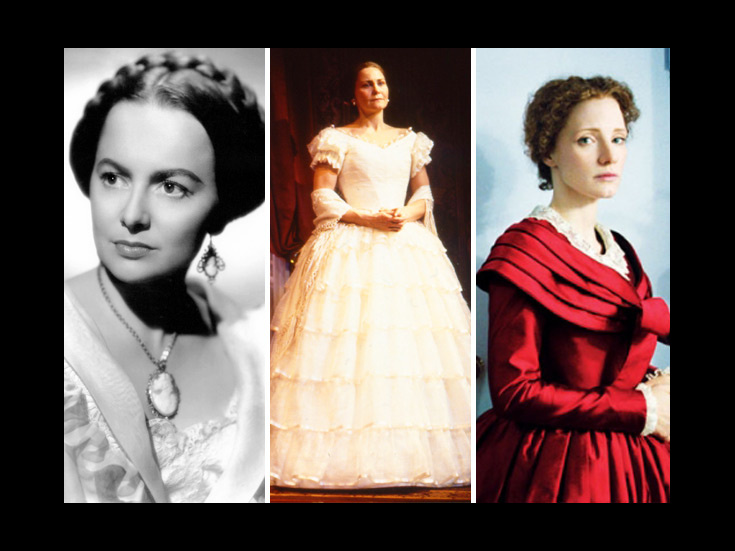For Love or Money: How The Heiress Charmed Audiences From Washington Square to Broadway
 Olivia de Havilland, Cherry Jones & Jessica Chastain as Catherine Sloper in 'The Heiress'
Olivia de Havilland, Cherry Jones & Jessica Chastain as Catherine Sloper in 'The Heiress'
(Jessica Chastain photo by Pari Dukovic)
The Heiress is bringing a taste of 19th-century New York charm to Broadway, starring Academy Award-nominee Jessica Chastain as Catherine Sloper and Downton Abbey’s Dan Stevens as her suitor, Morris Townsend. Read on below to chart the history of The Heiress from Henry James’ 1880 novella to the 2012 Broadway revival.

This Brilliant Stranger
Like many great artistic works, The Heiress was originally inspired by a piece of juicy gossip. In 1879, actress Fanny Kemble met with her novelist pal Henry James to spill the story of her younger brother, a fortune hunter. Kemble's sibling had proposed to a very rich but plain-looking woman, but he wasn’t in love with her. The woman (dubbed “Miss T.” in James' journal entry) fell head over heels for her suitor, but “her father disapproved strongly (and justly) of the engagement.” Eventually, the greedy beau got discouraged and disappeared. When Miss T.’s father died, he returned, but it was too late—the heiress refused to take him back.
Inspired by Kemble’s peculiar story, James wrote a serialized novella called Washington Square, published in both Cornhill Magazine and Harper’s New Monthly Magazine. Centering on a sheltered heroine named Catherine Sloper and her handsome pursuer, Morris Townsend, Washington Square became one of the author's most popular books and was favorably compared by critics to the works of Jane Austen. But James (who hated Austen) wasn’t proud of the novella, and chose to omit it from New York Edition, the comprehensive 24-volume collection of his fiction.

A Happy Ending
Husband-and-wife playwriting team Ruth and Augustus Goetz adapted Washington Square into a play of the same name in 1947, making a few significant modifications. After being pressed by a producer, the Goetzes changed the novella’s original ending to make it more upbeat: Instead of rejecting Morris when he returns, years after their original courtship, Catherine forgives him, and the couple lives happily ever after. After a failed tryout in Boston, the Goetzes retooled the play, restored its original ending and changed its name to The Heiress.
Directed by Jed Harris, The Heiress opened at Broadway’s Biltmore Theatre on September 29, 1947, starring British actress Wendy Hiller (who starred in the film adaptation of Pygmalion) as Catherine, Sherlock Holmes favorite Basil Rathbone as her father, Dr. Austin Sloper, and stage and film actor Peter Cookson as Morris. Although the production received mixed reviews—Brooks Atkinson of The New York Times insisted that James’ novella “can not be dramatized”—the play ran for 410 performances and was considered a hit.

Drama on the Set
After an Oscar-winning turn in To Each His Own, British film star Olivia de Havilland saw The Heiress and urged William Wyler to direct a movie version she could star in. (De Havilland had already demonstrated her mastery of shy heroines as Melanie in Gone With the Wind.) Wyler enlisted the Goetzes to pen a screenplay, but the writers soon became frustrated by the director's request to make Morris more likable.
His motive? Wyler had cast screen heartthrob Montgomery Clift, a young actor Paramount was trying to promote as a leading man—not a villain. According to Frank Miller of Turner Classic Movies, the Goetzes were baffled when their 19th-century suitor “showed up unshaven and wearing scruffy blue jeans” and appeared “too stooped for a man of the period.” To appease the screenwriters, Wyler enrolled Clift in period dance classes to improve his posture, but some critics still felt he looked too modern in the film, released in 1949.
Clift wasn't the only source of frustration on set. When Catherine discovers that Morris won't be eloping with her after all, de Havilland was instructed to walk up a flight of stairs, carrying her suitcase. Wyler forced her to do this so many times, the actress threw the suitcase at him in frustration. “At once, he realized the problem,” said Miller. “There was nothing in the suitcase. He ordered it filled with heavy props so that her efforts to drag it up the stairs perfectly captured her dejection.” Due in part to the iconic scene, de Havilland won a second Oscar for her performance—a turn so convincing, she was flooded with hate mail from Clift fans who couldn’t believe the actress would have the nerve to dump him.

Encore, Encore!
The Heiress has been revived three times on Broadway, including two short-lived productions: a 16-performance engagement in 1950, with Rathbone reprising his role as Dr. Sloper, and a 23-performance run in 1976, starring Tony winner Jane Alexander (The Great White Hope) as Catherine, David Selby as Morris and two-time Tony winner Richard Kiley (Man of La Mancha) as Dr. Sloper.
In 1995, Lincoln Center Theater transformed the Cort Theatre into the Slopers’ lavish Washington Square home for an Heiress revival starring Cherry Jones as Catherine, Tony winner Philip Bosco as Dr. Sloper, Frances Sternhagen as Catherine’s meddlesome Aunt Penniman and Jon Tenney (when went on to star in TV's The Closer and The Newsroom) as Morris. Jones, dubbed “a splendid young actress who’s new to me,” by Times reviewer Vincent Canby earned rave reviews as the “grossly shy” Catherine, and the Tony voters agreed. The Heiress earned four Tony Awards, including Best Revival of a Play and Best Actress in a Play for Jones’ inspired transformation from ugly duckling to strong-willed swan.

Written in the Stars
Moises Kaufman, director of Broadway hits I Am My Own Wife and 33 Variations, struck gold when he assembled his all-star cast for a 2012 revival of The Heiress. When Oscar nominee Jessica Chastain of The Help (who is anything but plain-looking on the red carpet) and Downton Abbey heartthrob Dan Stevens signed on to play Catherine and her suitor Morris, respectively, Kaufman expressed no concern that both would be making their Broadway debuts. “Both of them are really stage animals,” Kaufman told Broadway.com. “There’s a spark that happens in the room that is very thrilling.”
Although Chastain confessed to Vanity Fair that she felt “really, really terrified” to make her Broadway debut, the Juilliard graduate gained confidence thanks to Catherine’s own unfaltering strength. “It really is a tale of a modern woman,” Chastain told Broadway.com. “I was just blown away by how relevant it is to this day.” Like Chastain, Stevens was drawn to the “masterfully written” classic, adding, “it’s one of the best plays I’ve ever worked on.” Add stage and screen star David Strathairn as Catherine’s stern father and two-time Tony winner Judith Ivey as her busybody aunt, and The Heiress has become one of the season's most buzzed-about productions.
The touching and transformative story of a woman who finally gains the confidence to stand up to a man who betrays her has won the hearts of audiences through the ages, from a 19th-century novelist to an in-demand movie star. “It’s something that everyone will be able to relate to and find their own story in,” Chastain told Broadway.com. “That’s what I hope."
See The Heiress at the Walter Kerr Theatre, opening November 1!
Related Shows
Star Files
Articles Trending Now
- Death Becomes Her, Maybe Happy Ending, Oh, Mary! and More Earn Nominations for the 2025 Broadway.com Audience Choice Awards
- Maybe Happy Ending Will Be Hitting the Road on a National Tour, Launching Fall 2026
- Ali Louis Bourzgui Reflects on Joining Hadestown, His Upcoming Album and Processing the Experience of Tommy




